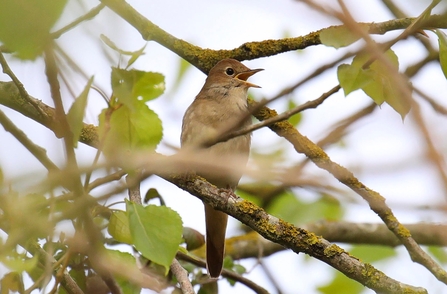Nightingale wise – we are hearing birds currently around the Kingfisher trail (blue) and at the start of Sayer’s Breck trail (red). Nightingales can sing throughout the day, but mornings and evenings tend to be best. The centre is open 10am to 5pm (refreshments available until 4:30pm). We have a couple of special evening events when you can listen and try to see nightingales on Wednesday 8th May as part of our Twilight Safari event from 8pm onwards and on Friday 10th May where wildlife guides will be available to take you out to nightingale hotspots to listen to their incredible song. We are at that time of year when a nightingale is often the first bird people hear when they park up- they are very fond of the thick scrub around the car park and field feeders.
Nightingales in full voice as spring really gets going
Ian Goodall

Nightingale by Ian Goodall
The call of the cuckoo is now being heard more and more on the reserve- we seem to have one or two birds back already from Africa and their song carries a long way- most visitors have heard one no matter where they have been on site. Blackcap are everywhere now and can be heard almost constantly, but it takes some practice to discern their warble from that of the garden warbler- though the song of the garden warbler, to me, sounds a bit more like a blackbird- more fluty and perhaps slightly slowed down compared to a blackcap. There aren’t as many garden warblers about but in the past week a bird has been vocal at the start of Sayer’s Breck trail and another in the willow scrub outside Double Decker hide this morning.
Garden warbler by Mike Andrews
Yesterday (27th) and today brought our first swift sightings of the year- seen in pairs over the Sailing Lake/Slough area and also from Bess’s Hide. Sailing Lake is also a good spot to look for house martin and swallow- these can usually be seen flying low over the water surface catching flies. Inside the Visitor Centre this year- we have a nest box camera wired up to one of our swift boxes under the eaves of the Centre- so when you visit do be sure to pop in and glance at it to see if nesting is underway- it’s a box they used last year and it’ll be a real privilege if we can watch these acrobats raise a family.
In terms of insects, although the past couple of days have seen cooler conditions, we are now up to eleven species of butterfly at the reserve- comma, speckled wood, red admiral, peacock, small tortoiseshell, small white, small copper, green-veined white, orange tip, brimstone and holly blue make up our range and any day now we hope we’ll see our first large red damselfly of 2019.
Brimstone on red dead-nettle by Mike Andrews
As well as animals, there are a few plants worth looking for if you visit- such as moschatel (‘moss-ka-tell’) or ‘town hall clock’ as it is also known. It’s a small, green-flowered herb growing in the shady path edges in Ash Carr, and very easily missed. It’s four green flowers are arranged in a square around the top of the stem, giving it a roughly cube-shaped flowerhead that resembles the dimensions of a town hall clock tower. Even smaller are the little geranium-like pink flowers of common stork’s-bill popping up in open, sunny spots such as in the bank joining the Visitor Centre to the Viewing Platform. As well as being pretty in its own right, it seems to be the foodplant of the brown argus butterflies at Lackford that we’ll see later in the season- it’s not the traditional foodplant often quoted for this species- common rock-rose- but this is a plant we don’t have at Lackford and last year I watched a couple of brown argus females egg-laying on the stork’s-bill, so it’s an important plant for us.
Common stork's-bill- usual red form and rarer white form by Heidi Jones
As we sit midway through spring, there is plenty more to look forward to on the reserve- in the coming weeks we should see swifts and swallows more frequently, a wider range of butterflies and the first damselflies should be on the wing. We’ll also start to see fledglings and young animals on site, as they try and learn the ropes of how to become an adult and how to look after themselves. If you see anything interesting on your visit, whether common or rare, please do let us know in the Centre- the more sightings we get the better.
